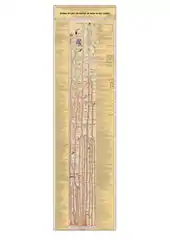James Forlong
James George Roche Forlong (6 November 1824 – 29 March 1904[1]) was a Major General of the Indian Army who trained as a civil engineer in Scotland and England. He was renowned for his road-building skills through the jungles of India and Burma[2] and for his studies on comparative religion.

Life
He was born at Springhall in Lanarkshire on 6 November 1824, the third son of William Forlong of Erines and his wife, who was the eldest daughter of General Gordon Cumming Skene of Dyce in Aberdeenshire.[3]
He joined the Indian Army in 1843 and fought in the Mahratha Campaign of 1845-46. He later filled various posts including that of Secretary and Chief Engineer to the government of Oudh. In 1858/59 he travelled extensively in Egypt, Syria and the Middle East.
Exposure to Indian religions while doing missionary work led him to abandon his Christian faith, and into some very heterodox ideas about religious origins, including those of the ancient Hebrews. These found expression in his massive work of comparative religion, Rivers of Life,[4] with its markedly sexual, some would say blasphemous,[5] interpretation of religious rites and symbolism.
He retired from the army in 1876 and then concentrated on writing, mainly on the comparison of various religions. His huge opus "Rivers of Life" was followed by "Faiths of Man: A Cyclopaedia of Religions" which was published posthumously in 1906.
Forlong was a rationalist. He was an Honorary Associate of the Rationalist Press Association,[6] to which he left a sum of money in his will.
He died at home, 11 Douglas Crescent in Edinburgh's West End[7] on 29 March 1904.[8] He is buried in Dean Cemetery in Edinburgh[9] with his wife Lavinia ("Nina") Reddie. The grave lies in the northern Victorian extension attaching the original cemetery on one of the north-south paths.
Rivers of Life

"...the shower of phallicism that burst upon the reading public in the shape of General Forlong's Rivers of Life".[10]
The book is in two large volumes together with a huge coloured Chronological Chart of the Religions of the World representing different currents:
All of these originated very early in mankind’s history, and form streams flowing down the millennia and separating and commingling into the major religions.
Some Themes
Like Payne-Knight, D’Hancarville and Hargrave Jennings he is of the phallicist school of religious anthropology. Phallic worship had two wings, the right hand, or lingam and the left hand path of the yoni worshipers,
The Garden of Eden story was simply that of human generation. Eve bruised the serpent’s head and he bruised what is euphemistically called her heel.
The Ark of the Covenant represented a female sex organ or yoni, and the two stones it contained signified testicles.
The early Jews practiced a most crude and extreme form of phallic worship. Elohim was the same as Baal and their worship was lingamist, the Yahweh worshiping revolt against it (spearheaded by the prophets) was a pro-yoni movement, like Indian Shaktism.
Christian churches are constructed on phallic principles. All these ideas are backed up with great erudition and parallels from antiquity, India and the far east.
Selected publications

- Rivers of Life (Volume 1, Volume 2, 1883)
- Through what Historical Channels did Buddhism Influence Early Christianity? (Open Court, 1887)
- Short Studies in the Science of Comparative Religions: Embracing All the Religions of Asia (1897)
- Faiths of Man: Cyclopaedia of Religions (3 volumes, 1906)
- Jainism and Buddhism ()
Quotes
The numerous tales of holy trees groves and gardens repeated everywhere and in every possible form justify me in my belief that Tree Worship was first known and after it came Lingam or Phallic, with of course the female form A-dama.[11]
He [the Serpent] is the special Phallic symbol which veils the actual God and therefore do we find him the constant early attendant upon Priapus or Lingam, which I regard as the second religion of the world.[12]
Phallic Worship, the second if not the first of man’s faiths. [13]
Notes and references
- Sources according to ancestry.com: "Ian Patterson's printouts, given to Robin; IGI"
- https://hermetic.com/sabazius/forlong
- Conder, C. R (1904). "Major-General Forlong, M.R.A.S". Journal of the Royal Asiatic Society of Great Britain and Ireland: 517–523. JSTOR 25208675.
- Rivers of life : Vols 1 and 2. or sources and streams of the faiths of man in all lands showing the evolution of faiths from the rudest symbolisms to the latest spiritual developments. B. Quaritch: London; Edinburgh, printed, 1883.
- See for example an orthodox view on this type of interpretation: "Such an interpretation of the Ark of the Covenant constitutes the highest blasphemy, and yet is precisely the perverted view which Antichrist will hold toward the Ark of the restored Jewish Covenant." Ralph Woodrow: Babylon Mystery Religion, Evangelistic Association Inc, Palm Springs 1966
- Gould, Frederick James. (1929). The Pioneers of Johnson's Court: A History of the Rationalist Press Association From 1899 Onwards. Watts. p. 28
- Edinburgh and Leith Post Office Directory 1904-5
- A Biographical Dictionary of Modern Rationalists, Watts & co London 1924
- https://www.flickr.com/photos/duncan/sets/72157644250829973/detail/
- H P Blavatsky - Buddhism, Christianity And Phallicism, in Lucifer, a Theosophical Magazine, 1896
- vol 1 p34
- vol 1 p93
- vol 1 p117